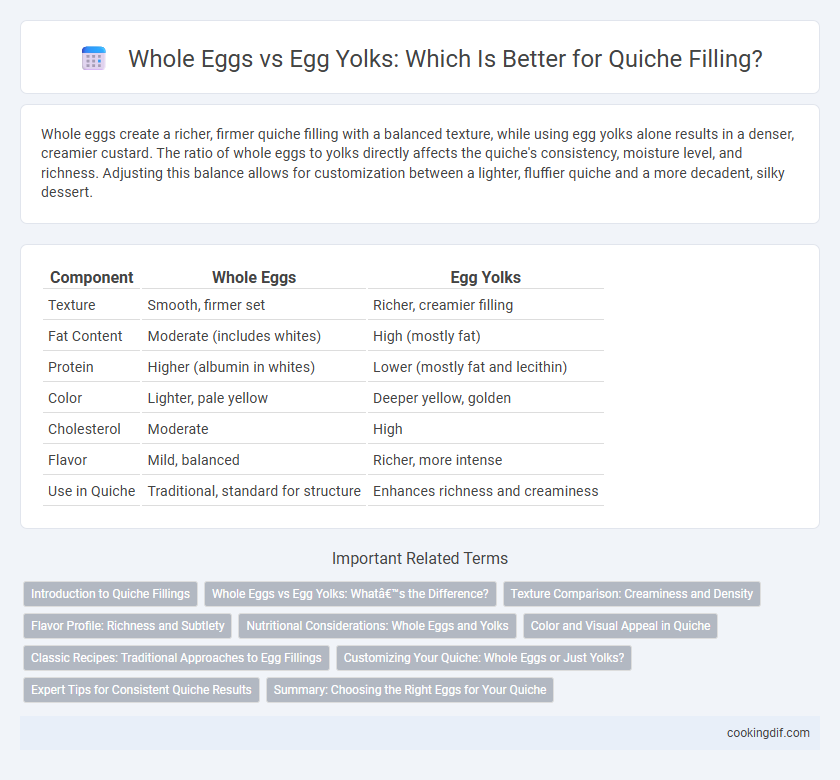Whole eggs create a richer, firmer quiche filling with a balanced texture, while using egg yolks alone results in a denser, creamier custard. The ratio of whole eggs to yolks directly affects the quiche's consistency, moisture level, and richness. Adjusting this balance allows for customization between a lighter, fluffier quiche and a more decadent, silky dessert.
Table of Comparison
| Component | Whole Eggs | Egg Yolks |
|---|---|---|
| Texture | Smooth, firmer set | Richer, creamier filling |
| Fat Content | Moderate (includes whites) | High (mostly fat) |
| Protein | Higher (albumin in whites) | Lower (mostly fat and lecithin) |
| Color | Lighter, pale yellow | Deeper yellow, golden |
| Cholesterol | Moderate | High |
| Flavor | Mild, balanced | Richer, more intense |
| Use in Quiche | Traditional, standard for structure | Enhances richness and creaminess |
Introduction to Quiche Fillings
Whole eggs provide structure and firmness to quiche fillings, creating a balanced texture that holds the ingredients together effectively. Egg yolks contribute richness and creaminess, enhancing the custard's smooth mouthfeel and depth of flavor. Combining whole eggs with extra yolks is a common technique to achieve a silky, yet stable quiche filling.
Whole Eggs vs Egg Yolks: What’s the Difference?
Whole eggs in quiche filling provide a balanced structure with both firmness from the whites and richness from the yolks, resulting in a custard that is tender yet holds its shape well. Egg yolks alone create a denser, creamier texture with more intense flavor but can produce a custard that is softer and less stable when baked. Using whole eggs offers a traditional quiche consistency with a smooth, sliceable filling, while yolks enhance richness but may require careful baking to avoid a runny center.
Texture Comparison: Creaminess and Density
Whole eggs in quiche filling create a balanced texture with moderate creaminess and light density, providing structure and a tender bite. Egg yolks contribute a richer creaminess and denser consistency due to their high fat content, resulting in a more custard-like, velvety texture. Using a combination of whole eggs and yolks allows for optimal creaminess while maintaining sufficient firmness to hold the filling together.
Flavor Profile: Richness and Subtlety
Using whole eggs in quiche filling provides a balanced richness with a creamy texture, enhancing the overall mouthfeel without overwhelming the palate. Egg yolks contribute intense, velvety richness and a subtle buttery flavor that deepens the quiche's savory profile. Adjusting the ratio of whole eggs to yolks allows precise control over the filling's flavor intensity and smoothness, achieving the desired harmony between richness and subtlety.
Nutritional Considerations: Whole Eggs and Yolks
Whole eggs provide a balanced mix of protein, fat, and essential nutrients such as vitamin D and choline, supporting overall health in quiche filling. Egg yolks are richer in fat and cholesterol but also contain higher concentrations of vitamins A, E, and B12, as well as antioxidants like lutein and zeaxanthin. Choosing between whole eggs and yolks in quiche filling depends on dietary goals, with whole eggs offering lower cholesterol and more protein, while yolks enhance richness and micronutrient density.
Color and Visual Appeal in Quiche
Whole eggs in quiche filling provide a balanced, creamy texture with a pale yellow color, enhancing the overall visual appeal by creating a uniform, inviting appearance. Egg yolks contribute a rich, deep golden hue that intensifies the quiche's color, making it look more vibrant and appetizing. Using a higher ratio of yolks can result in a visually striking quiche with a luscious finish that highlights the dish's richness.
Classic Recipes: Traditional Approaches to Egg Fillings
Classic quiche recipes emphasize whole eggs for a balanced texture that sets firmly while maintaining moisture, ensuring a custard-like consistency in the filling. Using only egg yolks increases richness and creaminess but can lead to a denser, heavier quiche that may not hold its shape as well. Traditional approaches often blend whole eggs with a small proportion of yolks to achieve an ideal custard that is both smooth and structurally stable.
Customizing Your Quiche: Whole Eggs or Just Yolks?
Whole eggs create a lighter, more custard-like quiche filling with balanced richness and moisture, ideal for traditional recipes. Using only egg yolks results in a denser, creamier texture with intensified flavor and a richer mouthfeel, perfect for indulgent or savory variations. Customizing the ratio of whole eggs to yolks allows precise control over texture and taste, tailoring the quiche to specific preferences or dietary needs.
Expert Tips for Consistent Quiche Results
Using whole eggs in quiche filling ensures a balanced custard texture by combining protein and fat, which helps the quiche set firmly without becoming rubbery. Incorporating extra egg yolks contributes richness and a creamier consistency, enhancing flavor and smoothness. Expert chefs recommend a ratio of three whole eggs to one or two yolks per quart of dairy to achieve consistent, tender quiche results every time.
Summary: Choosing the Right Eggs for Your Quiche
Selecting whole eggs for quiche filling creates a balanced texture with a rich, creamy consistency due to the combination of egg whites and yolks. Using only egg yolks results in a denser, custard-like filling with a more intense flavor and richer color. For optimal quiche texture and flavor, a ratio of whole eggs to yolks is recommended, commonly two whole eggs plus one yolk per cup of cream.
Whole eggs vs egg yolks for quiche filling Infographic

 cookingdif.com
cookingdif.com